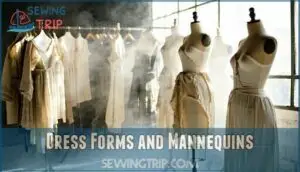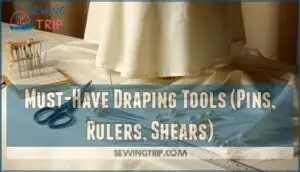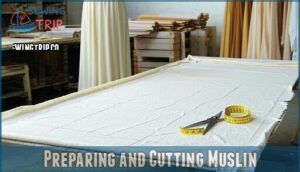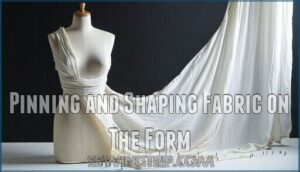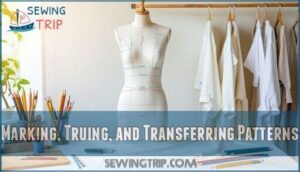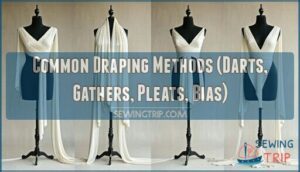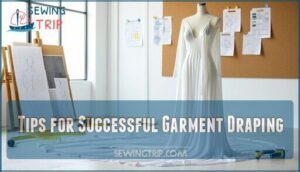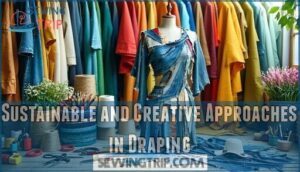This site is supported by our readers. We may earn a commission, at no cost to you, if you purchase through links.
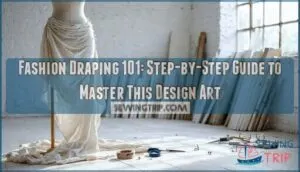 Fashion draping lets you sculpt fabric directly on a dress form, turning flat material into three-dimensional garments through strategic pinning and shaping. You’ll work hands-on with muslin or fashion fabric, manipulating it around the form’s curves to create silhouettes that would be nearly impossible to achieve through flat patternmaking alone.
Fashion draping lets you sculpt fabric directly on a dress form, turning flat material into three-dimensional garments through strategic pinning and shaping. You’ll work hands-on with muslin or fashion fabric, manipulating it around the form’s curves to create silhouettes that would be nearly impossible to achieve through flat patternmaking alone.
This ancient technique, perfected by civilizations like the Greeks and later revolutionized by designers like Madame Grès, gives you immediate visual feedback as your design takes shape. You’ll pin, tuck, and adjust fabric in real-time, watching how different materials behave and flow.
The beauty of fashion draping lies in its experimental nature—you’re not just following a predetermined pattern, you’re discovering new possibilities as the fabric guides your creative decisions. Once you master the fundamentals of grain direction and strategic pin placement, you’ll gain access to techniques that can transform even the simplest rectangle of cloth into stunning couture-worthy pieces.
Table Of Contents
Key Takeaways
- You’ll work hands-on with fabric directly on a dress form, sculpting three-dimensional garments that can’t be achieved through flat pattern making alone—this gives you immediate visual feedback as your design takes shape.
- Master grain direction and strategic pin placement first, as these fundamentals unlock advanced techniques like dart manipulation, gathering, pleating, and bias draping that transform simple fabric into couture-worthy pieces.
- Choose your fabric wisely—fluid materials like silk create graceful curves while structured cottons hold crisp lines, and the weight affects how your silhouette drapes and moves on the body.
- You can make draping sustainable by using zero-waste techniques, upcycling remnants, and working with eco-friendly materials while still creating professional-quality garments.
What is Fashion Draping?
Fashion draping lets you sculpt fabric directly on a three-dimensional dress form, transforming flat material into stunning garments through hands-on experimentation.
You’ll pin, tuck, and shape muslin or fashion fabric right on the form, watching your creative vision come to life in real-time rather than wrestling with flat patterns that mightn’t capture your design’s true essence.
Definition and Core Principles
Fashion draping transforms your creative vision into reality through 3D manipulation of fabric on dress forms. This hands-on approach lets you sculpt silhouettes directly, understanding fabric behavior while creating.
Unlike flat patterns, draping techniques offer immediate design visualization, making it the definitive tool for exploring fashion draping fundamentals and mastering silhouette creation through experimental fabric manipulation.
Brief History of Draping in Fashion
Ancient origins stretch back to 3500 BCE in Mesopotamia, where draping shaped civilization’s earliest garments. Greeks perfected the chiton and himation, while Romans mastered the toga. Medieval draping evolved through structured fits, leading to Renaissance artistry.
Modern masters like Madame Grès and Cristóbal Balenciaga transformed these historical techniques into today’s sculptural fashion, proving that ancient wisdom still guides contemporary design innovation.
Draping allows designers to visualize concepts on a dress form.
Draping Vs. Flat Patternmaking
Unlike flat patternmaking that starts with measurements on paper, fashion draping lets you sculpt directly on a dress form. This hands-on approach offers design freedom that patternmaking limitations can’t match.
You’ll see immediate results while creating sewing patterns becomes second nature.
Many designers use hybrid techniques, combining both methods for efficiency comparison and translating drape to pattern seamlessly.
Essential Tools and Materials for Draping
You can’t just dive into draping without the right setup. Getting your hands on quality tools and materials upfront will save you hours of frustration later.
Start with a solid dress form—it’s basically your 3D sketch pad. Add sharp fabric shears for clean cuts that won’t fray or pull your fabric apart.
Dress Forms and Mannequins
Your dress form becomes your creative partner in fashion draping. Adjustable forms let you customize measurements for a perfect fit, while vintage mannequins add character to your workspace.
Form padding helps achieve specific body shapes when standard sizes won’t work.
Consider draping alternatives like wire forms for experimental garment construction, though traditional dress forms remain the best practice for professional results.
Types of Fabrics for Draping
Now comes the fun part—choosing your fabric. Muslin remains your best friend for practice drapes, but don’t stop there.
Silk offers beautiful drape coefficient with elegant flow, while chiffon creates dreamy texture effects. Jersey’s stretch factor makes it forgiving for beginners.
Consider fiber content carefully—cotton holds structure, while synthetics might slip. Fabric weight determines your silhouette’s success.
Must-Have Draping Tools (Pins, Rulers, Shears)
Equip yourself with the right arsenal to transform your dress form into a masterpiece. Quality draping tools make the difference between amateur fumbling and professional precision.
- Sharp fabric shears – Your fabric’s first impression matters, and clean cuts set the foundation for perfect drapes
- Ergonomic pins with pinpoint accuracy – These tiny warriors hold your vision in place while you sculpt silhouettes
- Ruler versatility with French curves – From straight seams to flowing necklines, precise measurements guide your artistic vision
Tool maintenance keeps your shear sharpness consistent and rulers reliable for years of creative exploration.
Step-by-Step Fashion Draping Techniques
Think of this as your chance to sculpt fabric like clay, where each pin placement and fold adjustment brings your design idea closer to life on the dress form.
This is where your tools become extensions of your hands as you work through the actual draping process.
Preparing and Cutting Muslin
You’ll transform raw muslin into your creative canvas through careful prepping and cutting techniques. Start by checking the muslin grain—straight grain runs parallel to the selvage, while cross grain runs perpendicular. This fabric blocking step ensures your drape hangs correctly.
Choose appropriate muslin weights based on your design—lightweight for delicate silhouettes, medium-weight for structured pieces. Your draping tools should include quality fabric scissors for precision cuts that won’t fray edges or create uneven seams.
| Cutting Preparation | Waste Reduction Tips |
|---|---|
| Press muslin smooth before measuring | Save large scraps for practice drapes |
| Mark grain lines with chalk | Plan cuts to minimize leftover pieces |
| Use sharp scissors and shears for clean edges | Measure twice, cut once philosophy |
Pinning and Shaping Fabric on The Form
Once you’ve prepared your muslin, it’s time for the magic—pinning and shaping fabric on the dress form. Start by anchoring key points like shoulder seams and center front, then work outward with strategic pin placement.
Use fabric manipulation techniques to create volume control and silhouette creation through gentle stretching, folding, and gathering. Your securing techniques should allow the material to flow naturally while maintaining the desired shape for effective fit refinement.
Marking, Truing, and Transferring Patterns
Once you’ve shaped your fabric perfectly, mark seam allowance lines directly on the muslin while it’s still on the form. Use truing tools like French curves to smooth jagged lines and guarantee pattern accuracy.
Pay attention to muslin grain direction as you transfer markings. This truing process transforms your draped creation into a workable patternmaking blueprint, setting you up for design refinement and professional results.
Common Draping Methods (Darts, Gathers, Pleats, Bias)
Beyond basic shaping lies the artistry of sophisticated draping methods. Each technique transforms flat fabric into sculptural forms. Dart Manipulation creates precise fit through strategic fabric removal. Gather Distribution adds romantic volume while Pleat Variations offer structured elegance. Bias Grain draping flows naturally around curves, creating that coveted liquid silhouette. To achieve a professional finish with gathers, consider using the couture gathering method.
- Darts: Remove excess fabric for fitted fit at bust, waist, hips
- Gathering: Create soft volume through controlled fabric bunching
- Pleating: Form crisp, structured folds for geometric silhouettes
- Bias Draping: Cut on diagonal grain for natural body-skimming flow
- Fabric Volume: Manipulate fullness to achieve desired garment shape
Tips for Successful Garment Draping
Ready to take your draping from hobby-level to pro? Focus on three game-changers: picking the right fabric, nailing the fit, and knowing how to fix what goes wrong. These skills make all the difference between something that looks homemade and something that could hang in a boutique.
Once you’ve got these down, you’ll be able to troubleshoot tricky draping moments and turn your muslin experiments into patterns you can actually use. That’s how you go from playing with fabric to creating clothes people actually want to wear.
Choosing The Right Fabric for Silhouette
Your fabric choice makes or breaks your silhouette. Fluid fabrics like silk and jersey naturally fall into graceful curves, while structured cottons hold crisp lines.
Check the fabric weight and grain direction—lightweight materials drape softly, heavier ones create volume. Surface texture affects how light hits your design, changing its visual impact completely.
Achieving Accurate Fit and Proportion
Perfect fit starts with your dress form measurements. Check that your form matches your target size—even small discrepancies throw off proportions.
During drape refinement, step back frequently for balance assessment. Use symmetry techniques like measuring both sides equally.
Pin muslin mockups loosely at first, then tighten gradually. Watch how darts shape the silhouette—they’re your secret weapon for eliminating fit issues around seams.
Troubleshooting Common Draping Issues
Even perfect fits can go sideways when fabric fights back. Watch for these troublemakers that’ll throw your draping off course:
- Fabric Slippage: Your muslin shifts during pinning, creating loose areas
- Uneven Drapes: One side hangs differently, making asymmetrical designs look accidental
- Muslin Bulging: Too much fabric creates unwanted puffiness around darts
- Pattern Distortion: Seams twist or curve when they should stay straight
- Fit Issues: Armholes gap or necklines pull despite careful truing
Check your pins frequently and adjust tension as you work.
Translating Drapes Into Sewing Patterns
Once you’ve perfected your drape, it’s time to create your sewing pattern. Start by carefully truing your marked muslin pieces using rulers and French curves. Add seam allowances around all edges—usually ½ to ⅝ inch.
Mark grainlines clearly on each pattern piece and note any dart manipulation needed. Transfer these flat pattern pieces to paper patterns, including design ease measurements.
This patternmaking process transforms your three-dimensional creation into practical templates for construction.
Sustainable and Creative Approaches in Draping
Your draping practice can become a really cool eco-friendly art form. Zero-waste techniques and upcycled materials turn your fabric stash into something special—and the planet gets a break too.
Those fabric remnants you’d normally toss? They become the foundation for gorgeous silhouettes. You’re basically proving that being sustainable doesn’t mean sacrificing creativity—it actually makes you more inventive.
Zero-Waste and Eco-Friendly Draping Practices
You’ll discover that circular design principles transform your fashion draping approach completely. Focus on fabric sourcing from sustainable suppliers while mastering textile manipulation techniques that achieve minimal waste.
Natural dyes complement ethical production methods, creating garments where every fabric scrap has a purpose. Your garment design becomes a powerful statement about environmental responsibility through thoughtful fabric manipulation techniques.
Using Upcycled Materials and Remnants
Your remnant sourcing adventures can transform textile waste reduction into creative gold. Hunt through fabric stores’ leftover bins, vintage finds, and your own closet castoffs.
These scraps challenge your draping skills differently—working around existing seams and shapes forces inventive fabric manipulation techniques.
Creative repurposing becomes second nature as you adapt traditional draping methods to unconventional materials, developing sustainable aesthetics while mastering ethical considerations in fashion draping practice.
Inspiring Examples From Modern Designers
Contemporary couture masters like Alexander McQueen showcase avant-garde draping through sculptural silhouettes that defy gravity.
You’ll find inventive fabrics transformed into deconstructed forms—think Stella McCartney’s organic cotton wraps or Issey Miyake’s architectural pleats.
These conceptual designs prove that draping techniques in fashion can transform sustainable couture while pushing creative boundaries.
Frequently Asked Questions (FAQs)
What are the different types of dress forms?
You’ll encounter three main types: professional forms with cast iron bases for stability, adjustable forms that expand within limited size ranges, and full-body forms extending to ankles.
Choose based on your specific needs.
What are the different types of muslin?
When choosing muslin, you’ll pick your poison among three main weights: lightweight muslin is perfect for delicate drapes, medium weight muslin provides versatility, and heavy-weight muslin offers more structure.
What are the different types of pins used for draping?
You’ll use three main pin types: ballpoint pins for muslin that won’t snag fibers, glass head pins that resist iron heat, and fine silk pins for delicate fabrics.
What are the different types of marking tools used for draping?
Picture a seamstress’s toolkit like a painter’s palette—each marking tool creates different strokes on your fabric canvas.
You’ll rely on tailors chalk, water-erasable markers, and tracing wheels to capture design details during draping sessions.
What are the different types of pressing tools used for draping?
Your pressing toolkit should include a steam iron for smoothing fabric and creating sharp creases, a pressing cloth to protect delicate materials, and a seam roll for curved seams.
How do professional designers price draping services?
Professional pricing pivots on project complexity and your experience level. You’ll usually charge $35-250 hourly, with established designers commanding higher rates for intricate three-dimensional garment construction expertise.
What career paths require advanced draping skills?
You’ll find sophisticated draping skills essential for haute couture designer roles, theatrical costume design, bridal design roles, fashion design entrepreneurship, and specialized pattern-making careers in luxury fashion houses.
Can draping techniques work for menswear design?
Everyone assumes menswear can’t handle draping’s flowing techniques, but you’ll find structured fabrics respond beautifully to 3D manipulation.
Men’s dress forms enable precise tailoring experiments for suits, jackets, and contemporary silhouettes.
How long does learning basic draping take?
You’ll grasp basic techniques in 2-4 weeks with daily practice. Mastering fundamental skills like pinning, sculpting simple silhouettes, and understanding fabric behavior takes consistent hands-on work.
Which fashion schools offer specialized draping programs?
You’ll find draping specializations at FIT (Fashion Institute of Technology), Parsons, LATTC (Los Angeles Trade-Technical College), and College for Creative Studies in Detroit.
These programs teach hands-on sculpting techniques alongside traditional construction.
Conclusion
Think of it like a sculptor working with clay—you’ve learned to see potential garments hiding in plain fabric through draping. Now you can work with muslin on dress forms, building three-dimensional pieces that flat patterns just can’t match.
Fashion draping lets you sculpt fabric directly on dress forms, transforming flat material into three-dimensional garments that flat patterns simply cannot achieve
Master these pinning techniques, trust your fabric’s natural flow, and embrace the experimental process. Fashion draping transforms simple cloth into couture magic—your hands are now the sculpting tools that bring design dreams to life.
- https://www.jdinstitute.edu.in/draping-techniques-types-and-importance/
- https://www.uniformmarket.com/statistics/global-apparel-industry-statistics
- https://www.iiftbangalore.com/blog/what-is-draping-and-its-importance/
- https://theacademic.in/wp-content/uploads/2025/08/168A.pdf
- https://bizplanr.ai/blog/fashion-industry-statistics

